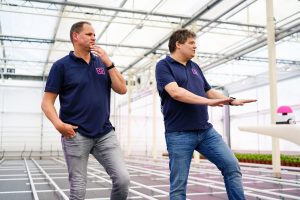Explore the groundbreaking inauguration of “The Greenhouse,” an innovative project spearheaded by Division Q at Koppert Cress. This Dutch greenhouse, featuring pioneering ‘bubble wrap’ insulation technology, not only marks a significant milestone in sustainable horticulture but also serves as an experimental hub for agricultural startups. Delve into the journey of overcoming challenges, honoring visionaries, and fostering a culture of innovation in the agricultural sector.
—
Amidst the challenges of the COVID-19 pandemic, the agricultural community witnessed a remarkable feat of innovation with the unveiling of the Division Q Broeikas at Koppert Cress. This state-of-the-art greenhouse, equipped with energy-efficient ‘bubble wrap’ insulation, stands as a testament to the relentless pursuit of sustainability and technological advancement in modern farming practices.
The brainchild of Anton Paardekooper, the concept of insulating greenhouses with soap bubbles captured the imagination of many. However, tragedy struck in late 2022 when Anton passed away unexpectedly, halting the project in its tracks. Despite this setback, the collective efforts of dedicated individuals, supported by initiatives like Kansen voor West, reignited the project’s momentum, leading to its completion.
The symbolic inauguration of “The Greenhouse” not only commemorated the vision of Anton but also symbolized a beacon of hope for the future of agriculture. Stephanie, Anton’s wife, ceremoniously opened the greenhouse, signifying a poignant moment of unity and perseverance.
The collaborative spirit of this endeavor is reflected in the contributions of various stakeholders, from contractors like Bransen Group and PB tec to the tireless efforts of the BBBLS team. Moreover, the unwavering commitment of individuals like Hendrik Jan van den Ende exemplifies the resilience and determination required to realize ambitious projects in the agricultural domain.
Looking ahead, “The Greenhouse” represents more than just a physical structure; it embodies a philosophy of fostering innovation and sustainability within the agricultural sector. As we collectively strive to mitigate the impacts of climate change, initiatives like this serve as catalysts for transformation, inspiring the next generation of agricultural pioneers to push the boundaries of possibility.
In essence, “The Greenhouse” beckons not only as a sanctuary for cultivating crops but also as a fertile ground for nurturing ideas and fostering collaboration. It is a testament to the indomitable spirit of innovation that defines the agricultural community, inviting aspiring entrepreneurs and visionaries to join in shaping a more sustainable future for farming.



Conclusion:
The inauguration of “The Greenhouse” marks a significant milestone in the journey towards sustainable agriculture, showcasing the power of collaboration, innovation, and perseverance. As we embrace the challenges of the future, let us harness the spirit of ‘The Greenhouse Effect’ to cultivate a thriving ecosystem of innovation in agriculture, inspired by the legacy of visionaries like Anton Paardekooper.










